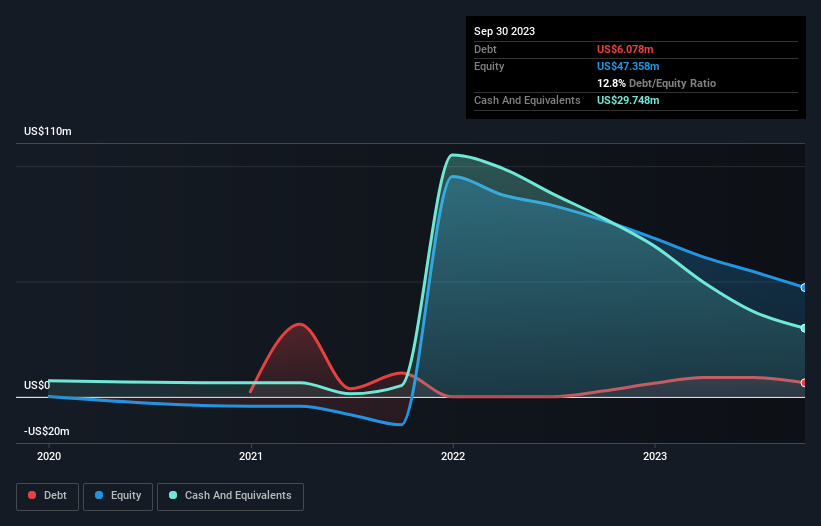Legendary fund manager Li Lu (who Charlie Munger backed) once said, 'The biggest investment risk is not the volatility of prices, but whether you will suffer a permanent loss of capital.' So it might be obvious that you need to consider debt, when you think about how risky any given stock is, because too much debt can sink a company. Importantly, Backblaze, Inc. (NASDAQ:BLZE) does carry debt. But is this debt a concern to shareholders?
What Risk Does Debt Bring?
Debt and other liabilities become risky for a business when it cannot easily fulfill those obligations, either with free cash flow or by raising capital at an attractive price. Part and parcel of capitalism is the process of 'creative destruction' where failed businesses are mercilessly liquidated by their bankers. However, a more common (but still painful) scenario is that it has to raise new equity capital at a low price, thus permanently diluting shareholders. Of course, plenty of companies use debt to fund growth, without any negative consequences. When we think about a company's use of debt, we first look at cash and debt together.
See our latest analysis for Backblaze
How Much Debt Does Backblaze Carry?
As you can see below, at the end of September 2023, Backblaze had US$6.08m of debt, up from US$2.54m a year ago. Click the image for more detail. But it also has US$29.7m in cash to offset that, meaning it has US$23.7m net cash.

A Look At Backblaze's Liabilities
We can see from the most recent balance sheet that Backblaze had liabilities of US$61.0m falling due within a year, and liabilities of US$26.4m due beyond that. Offsetting this, it had US$29.7m in cash and US$4.81m in receivables that were due within 12 months. So it has liabilities totalling US$52.8m more than its cash and near-term receivables, combined.
Given Backblaze has a market capitalization of US$289.1m, it's hard to believe these liabilities pose much threat. Having said that, it's clear that we should continue to monitor its balance sheet, lest it change for the worse. While it does have liabilities worth noting, Backblaze also has more cash than debt, so we're pretty confident it can manage its debt safely. When analysing debt levels, the balance sheet is the obvious place to start. But ultimately the future profitability of the business will decide if Backblaze can strengthen its balance sheet over time. So if you're focused on the future you can check out this free report showing analyst profit forecasts.
In the last year Backblaze wasn't profitable at an EBIT level, but managed to grow its revenue by 19%, to US$96m. That rate of growth is a bit slow for our taste, but it takes all types to make a world.
So How Risky Is Backblaze?
By their very nature companies that are losing money are more risky than those with a long history of profitability. And we do note that Backblaze had an earnings before interest and tax (EBIT) loss, over the last year. And over the same period it saw negative free cash outflow of US$36m and booked a US$62m accounting loss. Given it only has net cash of US$23.7m, the company may need to raise more capital if it doesn't reach break-even soon. Summing up, we're a little skeptical of this one, as it seems fairly risky in the absence of free cashflow. When analysing debt levels, the balance sheet is the obvious place to start. But ultimately, every company can contain risks that exist outside of the balance sheet. To that end, you should be aware of the 4 warning signs we've spotted with Backblaze .
If, after all that, you're more interested in a fast growing company with a rock-solid balance sheet, then check out our list of net cash growth stocks without delay.
Valuation is complex, but we're here to simplify it.
Discover if Backblaze might be undervalued or overvalued with our detailed analysis, featuring fair value estimates, potential risks, dividends, insider trades, and its financial condition.
Access Free AnalysisHave feedback on this article? Concerned about the content? Get in touch with us directly. Alternatively, email editorial-team (at) simplywallst.com.
This article by Simply Wall St is general in nature. We provide commentary based on historical data and analyst forecasts only using an unbiased methodology and our articles are not intended to be financial advice. It does not constitute a recommendation to buy or sell any stock, and does not take account of your objectives, or your financial situation. We aim to bring you long-term focused analysis driven by fundamental data. Note that our analysis may not factor in the latest price-sensitive company announcements or qualitative material. Simply Wall St has no position in any stocks mentioned.
About NasdaqGM:BLZE
Backblaze
A storage cloud platform, provides businesses and consumers cloud services to store, use, and protect data in the United States and internationally.
Flawless balance sheet and fair value.
Similar Companies
Market Insights
Community Narratives



